Birding Arizona during the monsoon
Note: This is the eighth in a series of occasional blog posts by GGBA member George Peyton about his other half Lani Rumbaoa’s effort to see over 600 bird species in the Lower 48 states in 2015.
By George Peyton
Southeast Arizona (SEAZ) is justly famous for harboring a number of Mexican bird species that barely cross the border into that region and are often found nowhere else in the United States. This was to be the last place this year where Lani could add a significant number of new species to her Big Year List. When we started on July 27, Lani’s List was up to 535 for 2015, and I estimated that if she were very lucky, she could add 35 to 40 new species.
We were fortunate that our close birding friend Bob Hirt (Birder Bob) — who had done an exceptional job as Lani’s unofficial guide on the Texas Coast during April — agreed once more to act in that capacity in Southeast Arizona. Bob spent a huge amount of time before the trip researching where to see the maximum number of species in SEAZ, so that each day we had a detailed itinerary with at least four or five different birding stops, each aimed at finding one or two specific Target Species.
Our trip to Southeast Arizona was specifically timed to coincide with the summer monsoon rains that bring a “second spring,” i.e., a second breeding season for many species of birds. The lush green landscape and cooler temperatures brought about by near-daily rains over two to three weeks are in stark contrast to the extremely hot, dry summer climate with temperatures up to 110 degrees in much of the rest of Arizona during that period.
Most people in California have never heard of the SEAZ monsoon rains in late July and early August, but it is often the best time to see the Mexican bird specialties, particularly hummingbirds such as Violet-crowned, White-eared, and Lucifer, as well as Plain-capped Starthroat.
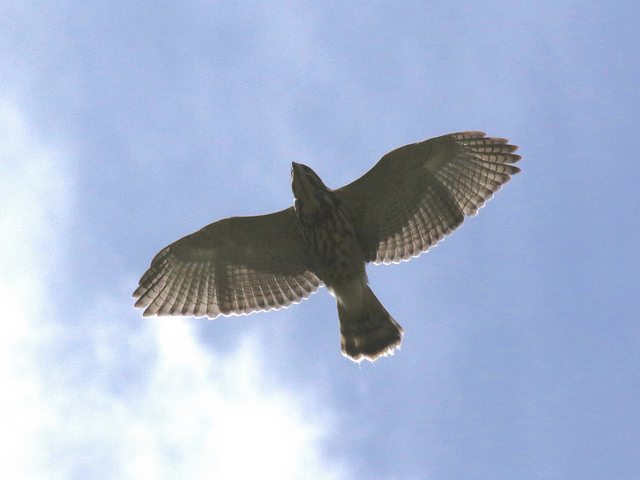

We flew into Phoenix and directed our rented Jeep Cherokee right away to Encanto Park Golf Course, the only place in the U.S. where Rosy-faced Lovebirds can be found. Lani’s sharp eyes picked out a pair within one minute of our arrival, about 100 feet away under a tree.
Then we drove about 45 miles west of Phoenix to Thrasher Corner, where four species of Thrashers have been identified. But in the mid-afternoon Arizona heat we were only able to locate a family of four Bendire’s Thrashers, as well as the relatively common Curve-billed Thrasher. We finished the day by driving several more hours to Tucson.
We were up early the next day since it would be a long one, starting at Sabino Canyon on the northern outskirts of Tucson — desert and semi-desert environment with large saguaro cacti, where Lani added five Year Birds, including Rufous-winged Sparrow, Black-tailed Gnatcatcher, and Broad-billed Hummingbird.
After several hours of birding at Sabino Canyon, we began driving up Mt. Lemmon, moving from the desert up to a ski resort, climbing thousands of feet into forests of pines and Douglas firs, passing through one Life Zone after another, each with its differing variety of bird species. Lani added 10 more new species to her Big Year List. Red-faced, Grace’s, and Olive Warblers were among the highlights, as were Magnificent, Broad-tailed, and Rufous Hummingbirds, but the real surprise was finding a Common Black Hawk at Rose Canyon Lake, high up on the mountain. Mt. Lemmon is a unique location that all birders should set aside a day to visit when birding Southeast Arizona.
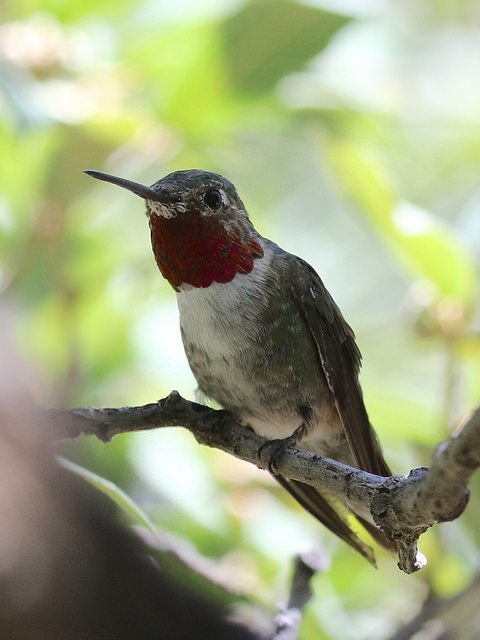
Early wake-ups are definitely part of Big Year Birding, and most mornings during our two weeks in SEAZ I was up sometime between 4 and 4:30 a.m. This early morning we started birding in the East Unit of Saguaro National Monument on the eastern outskirts of Tucson, where Lani added Gilded Flicker and Canyon Towhee, and not far away a Lucy’s Warbler, all against a background of stately saguaros with their arms soaring high and wildflowers blooming in response to the monsoon rains.
By 9 a.m. we were driving east on I-10, where we ended up in Chiricahua National Monument, East Unit, with its stunning rock formations, where Apaches found sanctuary from the increasing tides of white settlers, and where Lani added Mexican Chickadee and Zone-tailed Hawk to her List.
As we drove over the very top of the Chiracahua Mountains on our way to Portal, Arizona, Lani saw a Cordillerran Flycatcher, and at the Southwest Research Station on the east side of the Chiracahuas she added Blue-throated Hummingbird.
The Chiracahua Mountains are famous in birding circles, and from the east side where Portal is located, the huge rock monoliths jutting up into the sky remind one a bit of Yosemite Valley. During the next two days of great birding, Lani added nine more species to her Big Year List, including Hepatic Tanager, Sulphur-bellied Flycatcher, and Varied Bunting.
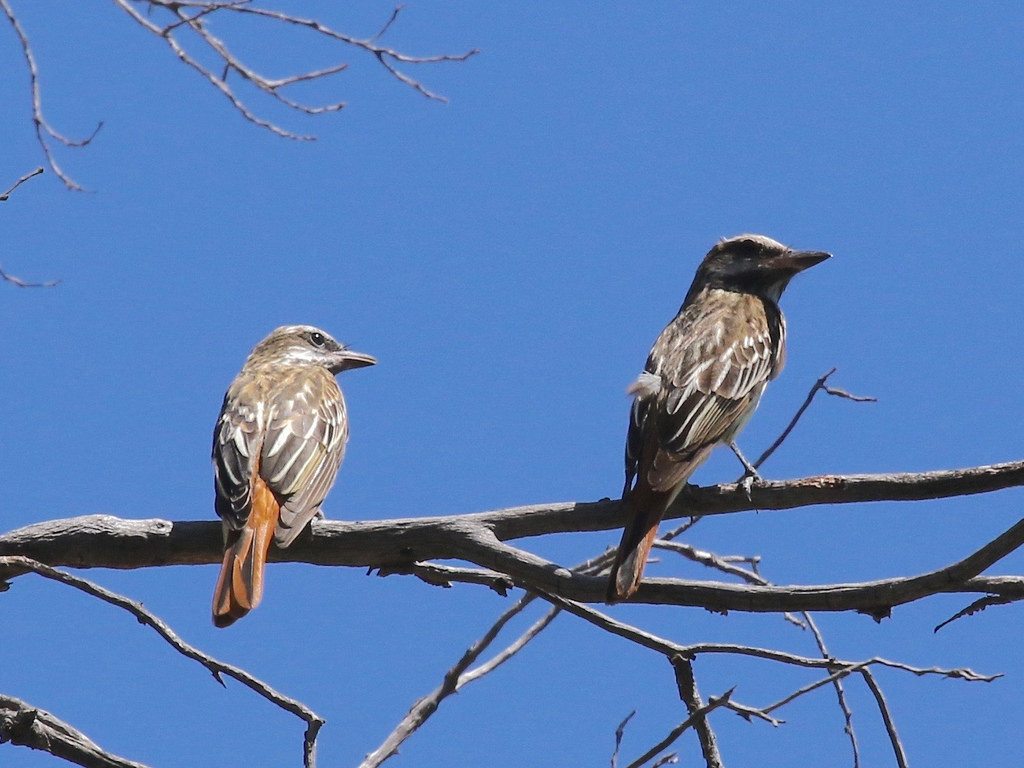
We had three special birding memories from those two days. First, we stopped by the yard of Dave Jasper, a well-known bird leader and owling expert, who joined us in viewing his many hummingbird and seed feeders. As Dave was eating his breakfast next to us, he suddenly jumped up, pointed into the sky, and showed us a soaring Goshawk, a very difficult-to-see hawk species, which Lani was thrilled to see.
Later that same day we stopped at the Big Thicket, another well-known bird-feeding area, which Dave Jasper had developed near his former Portal home. As we sat looking at the feeders, suddenly we saw another form of wildlife slithering along the ground — a large and fat Western Diamondback rattlesnake, particularly attracted by the wild mice that ate the seeds falling from the feeders. As we watched the rattlesnake move back and forth over a 450-square-foot area, another birder called out a sighting of a Plain-capped Starthroat, a rather rare hummingbird from Mexico. Lani was happy to add that bird as both a Lifer and a Year Bird.
The other memorable event in the Chiracahuas occurred along the South Fork of Cave Creek where we were looking for Elegant Trogon. I decided to walk upstream along the bank on my own, and about 125 feet further along I was startled in knee-high vegetation by a sudden explosion of activity: I had unknowingly stepped into the middle of a family group of 12 or more Montezuma Quail. The female flew across the Creek, but the male suddenly emerged in a nearby small clearing and moved to the top of a rock about 20 feet from me. He sat there in the open for almost 10 minutes, attracting my attention away from his young while I marveled at his unique and beautiful head pattern. I first was shown this bird by legendary California birder and good friend Rich Stallcup in 1970, when it was still known as a Harlequin Quail, and it had been 45 years before my eyes would rest on it again, so this was a special thrill. Lani fortunately saw Montezuma Quail several times on the trip.
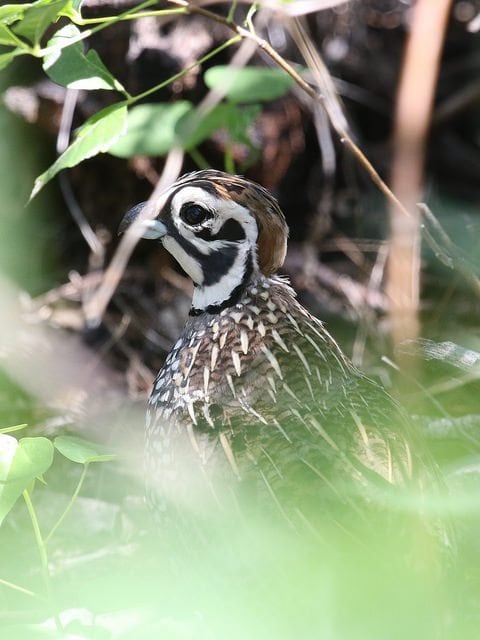
There were a number of other special birds that Lani saw during our SEAZ trip. Bob Hirt took us to his one-acre property immediately adjacent to a Nature Conservancy grassland reserve in Lower Ramsey Canyon, and Lani was treated to the sight of a singing Botteri’s Sparrow at close range. That same day Lani saw a Violet-crowned Hummingbird at the Nature Conservancy Visitor Center further up Ramsey Canyon.
The next morning Lani and I started on a four-mile round-trip hike up what became a very steep trail in Upper Ramsey Canyon in search of a very rare bird species, Tufted Flycatcher, which infrequently ventures north from Mexico and which had been located several weeks before. When we finally reached the landmark for where the Tufted Flycatcher had been sighted, we and other birders spread out up and down the trail and started scanning the tall conifers. About 15 minutes later someone came running up the trail, saying that the Tufted Flycatcher had been spotted. We ran about 250 yards back down the trail, and then saw birders disappearing up a steep slope to a remote spot another 70 yards away.
Fortunately for Lani, John Coons and Tom Johnson — two excellent Field Guides leaders — had heard the Tufted Flycatcher calling well off of the trail in a location where no one would ever have been able to see it from the trail. This cute little flycatcher with a pert crest kept flying out to catch insects and coming back to the exact same perch in the thick woods, so Lani had great views of this very rare bird, well worth our strenuous hike.
The very next morning we started out early up another trail, this time up Miller Canyon in search of the Mexican Spotted Owl, a subspecies of the our Spotted Owl in California that may someday be split into a separate species. After climbing for over a mile, we came to the area where a family of Mexican Spotted Owls had been seen off and on for a month or so. We ran into a birding group from Minnesota and together saw another very cute owl, a subspecies of the Northern Pygmy-Owl called the Mountain Pygmy-Owl that may also be split into its own separate species.

After awhile the Minnesota birding group gave up on the Spotted Owl and left. I asked our local guide Laurens Halsey if we could go further up the trail and then work our way back, searching carefully up and down each tree for a Spotted Owl. Suddenly, after about 20 minutes searching, Laurens said that he had the bird, and in a spot almost totally hidden from view, there was the Mexican Spotted Owl. How Laurens ever was able to spot the Owl is a mystery to me, since it was totally hidden except from one extremely restricted viewpoint. Having an expert bird guide to help track down a key Target Species can be invaluable, and Laurens Halsey is one of the top guides in Southeast Arizona.
A final special memory was driving the lengthy gravel roads into remote California Gulch in search of two very difficult-to-see species, again with the help of another very good birding guide, Richard Fray.
After a number of miles bumping along gravel roads close to the border, seeing only Border Patrol vehicles along the way, we finally stopped. Soon after getting out of our car, Lani had a great view of a Five-striped Sparrow, a beautifully marked bird that is only found in the U.S. in this relatively small area near Mexico.
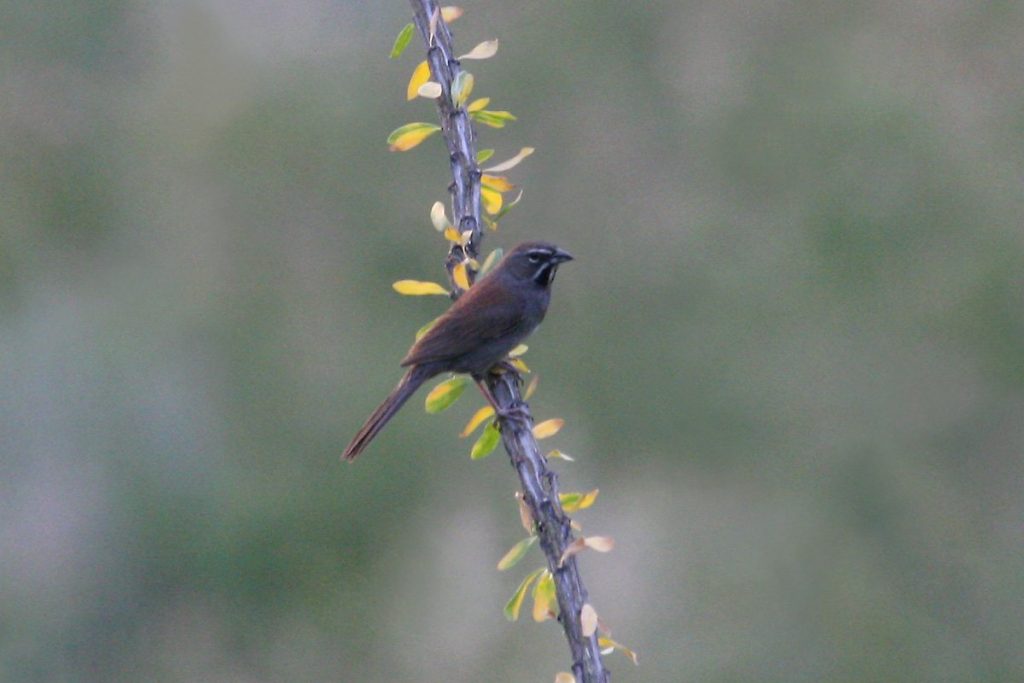
Then we were off for more miles of driving along remote roads before we finally reached a location where the Mexican species Buff-collared Nightjar just makes it across the border into Arizona. We were there just before dark, and Richard took us to where he had regularly seen the Nightjar during its breeding season, pointing out its favorite perches and mentioning that it would be migrating back south into Mexico in a few weeks.
We looked and listened and finally played the Nightjar’s call but could find nothing. Bats were flying around along with thousands of some type of nocturnal fly that constantly bumped into our faces in the dark, but still no Nightjar. Richard persisted in shining his spotlight on every tree and bush in the area, and finally he exclaimed that he had “eye shine,” two bright orange dots hidden in a dense juniper tree. Soon we had very good views of the Nightjar, one of the most difficult-to-see species in Arizona.
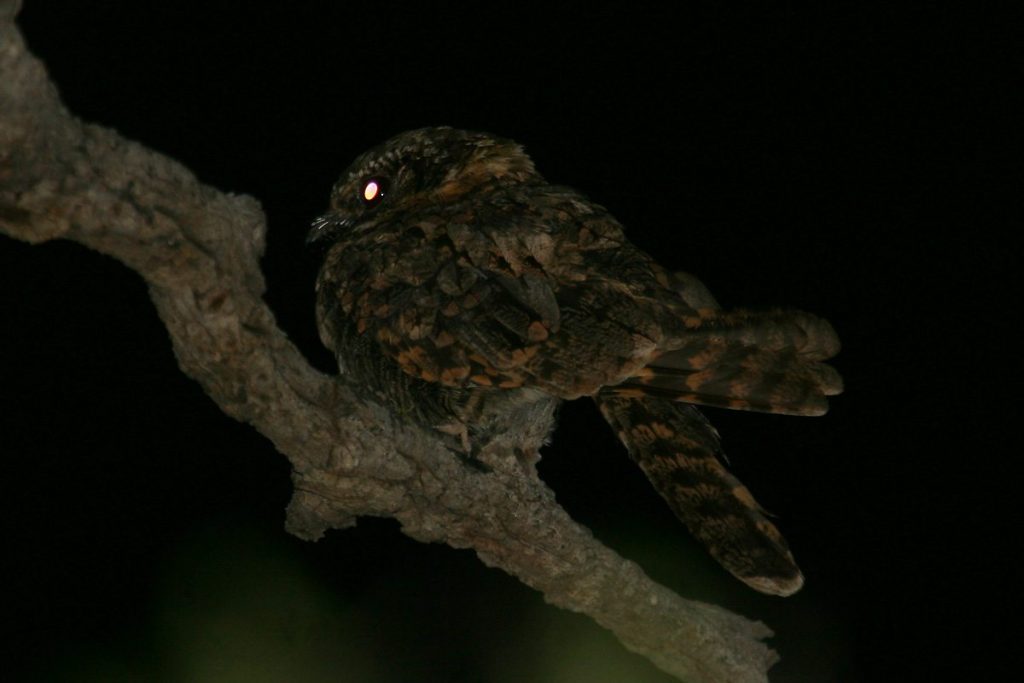
All in all, Southeast Arizona was a great success for Lani. Instead of the 35 to 40 species I had estimated, she actually added 50 new birds, bringing her Big Year List up to 585 species, much due to the excellent leadership of Bob Hirt, Laurens Halsey, and Richard Fray.
We returned from Arizona just 15 species short of Lani’s initial goal of seeing 600 bird species in the Lower 48 States during 2015.
P.S. Since she returned from Arizona on August 10, Lani has birded as frequently as possible here in California, along with working at her regular job, and reached her initial goal of seeing 600 species during 2015 in the Lower 48 States by late August. As of October 20, her Big Year List reached an amazing 617 bird species.
—————————————
George Peyton practiced law for 44 years, dividing his time between a private practice and work as Piedmont City Attorney. He has served on the boards of Golden Gate Bird Alliance, Point Blue (formerly PRBO), Audubon Canyon Ranch, and National Audubon. He played a leading role in National Audubon’s work to save Mono Lake. He has been an active birder for 66 years and seen about 6,500 bird species. Click here to read his previous posts on Lani’s Big Year.
